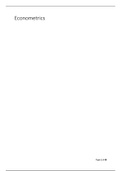Samenvatting
Econometrics detailed Lectures and Book summary
- Vak
- Econometrics
- Instelling
- Universiteit Utrecht (UU)
This summary helped me, a social sciences student, pass econometrics with a whopping 8,6! This summary does not only summarize the lectures, it also provides supplements from the book which were not in the lecture. Especially to those who are not as proficient with econometric formulas, I spend a l...
[Meer zien]




